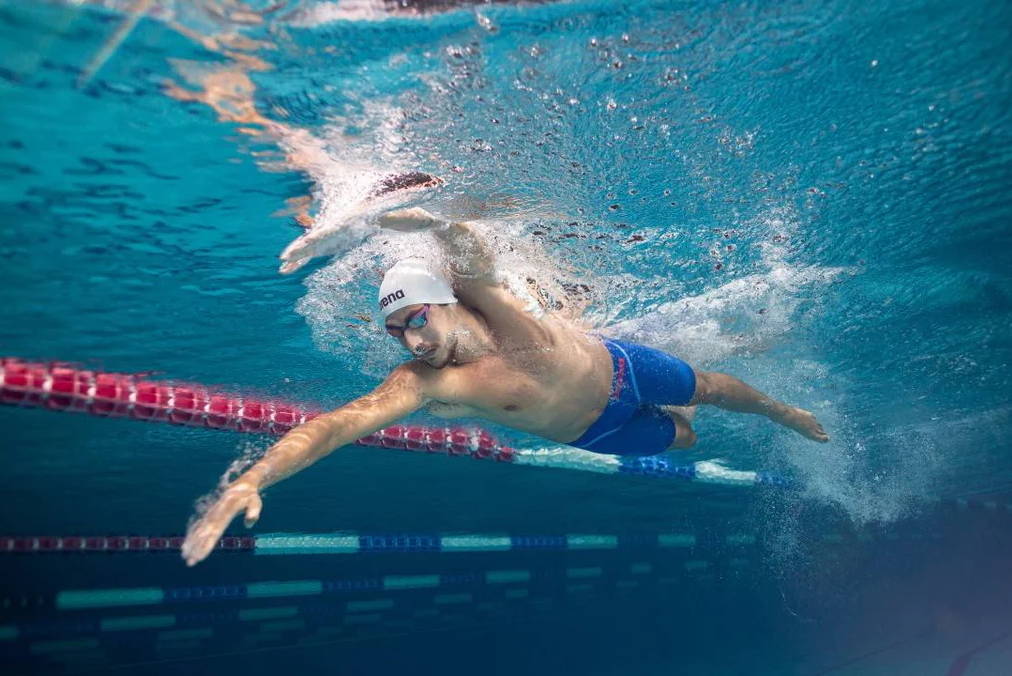Wenn man beim Schwimmen über Reduktion auf's Wesentliche spricht, dann kommt man um die Themen Wasserlage, Armzug, Atmung und Erholung nicht herum. Wir haben wir euch kurz beschrieben, was jeweils zu beachten ist und welche Übung am besten hilft.
Wasserlage und gleiten
In jedem unserer Schwimm-Seminare „reiten“ wir auf diesem Thema herum. Das Aller-Wichtigste beim Schwimmen ist die Wasserlage. Der Körper sollte möglichst flach an der Wasseroberfläche liegen. So reduziert Ihr Euren Querschnitt in Schwimmrichtung und habt den kleinstmöglichen Wasserwiderstand. Um eine gute Wasserlage zu erreichen, sind eine gute Rumpf-Stabilität und ein guter Beinschlag nötig. Nur wer eine gute Wasserlage hat kann, auch optimal gleiten und schnell schwimmen. Diese beiden Fähigkeiten gehen beim Schwimmen Hand in Hand.
Übung: In jedes Training gehören 200-400m Beinschlag. Hier kann gern die Bauchlage mit Seiten- und Rückenlage abgewechselt werden. Jeder Athlet sollte 2-3mal pro Woche für ca. 30 Minuten seine Rumpfmuskulatur trainieren.
Armzug
Wenn Ihr Eure Wasserlage in den Griff bekommen habt, solltet Ihr als Nächstes an Eurem (Unterwasser-) Armzug arbeiten, denn der Armzug gibt Euch den - für's Schwimmen nötigen - Vortrieb. Auch hier ist der erste Schritt das Gleiten, anschließend kommen das Wasser-Fassen, die Zug- und die Druckphase. Achtet darauf, dass Ihr Eure Schulter nicht durch einen gestreckten Armzug überlastet und sorgt mit einem dynamischen Abdruck in der Druckphase für den optimalen Vortrieb.
Übung: Die besten Übungen für den Armzug sind einseitige Armzüge, sowie die klassischen „Skulling-Übungen“. Brett und Flossen sind gute Hilfsmittel, um den Fokus auf einzelne Facetten zu legen.
Erholung
Das Schwimmen ist eine zyklische Bewegung. Das heißt, die Belastung findet unter Wasser statt, der Überwasser-Teil ist (eigentlich) die Erholungsphase, um wieder fit für den nächsten Zug zu werden. Wer also sowohl unter als auch über Wasser Arme und Schultern maximal anspannt, hat keine Erholungsphase und ist ziemlich schnell platt.
Das heißt, über Wasser muss der Arm möglichst locker (hoher Ellbogen) nach vorne geführt werden und die Muskeln erhalten dann die wohlverdiente Pause vor dem nächsten Armzug.
Übung: Dehnen und Krafttraining für den oberen Rücken helfen um die Schulterpartie beweglicher zu machen. Im Techniktraining sind Reißverschluss und Wasserschleifen gute Übungen, um die Lockerheit beim Vorholen des Arms zu steigern.
Atmung
Ohne Sauerstoff geht nichts...daher müssen wir einfach irgendwann atmen, um (leben und) uns weiter bewegen zu können. So banal es sich anhört: Als Kraul-Schwimmer muss man unter Wasser aus und über Wasser einatmen. Um es noch genauer auf den Punkt zu bringen. Wenn ihr nicht mit dem Ausatmen fertig seid, aber schon den Kopf zum Atmen seitlich aufdreht bekommt Ihr ein Timing-Problem, denn dann fehlt die Zeit, um noch ausreichend viel einzuatmen.
Übung: Hier bietet sich eine Übung mit Brett an, unter Wasser so lange auszuatmen, bis die Lunge komplett entleert ist. Erst dann folgt ein Armzug mit Atmung. Dann geht die Übung von vorne los.
Zugehörige Kategorien




















